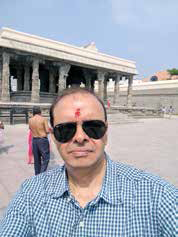Seen through the eyes of people who have never really understood the South beyond the ‘Madrasi’ collective label, the wonders of the South came alive through the little temple towns we visited, the local foods we sampled, the music we heard and the conversations we had with temple guides and drivers
 Ganesh Natarajan at Thanjavur, Tamil Nadu
Ganesh Natarajan at Thanjavur, Tamil NaduThere has been a surge of holiday travellers to foreign lands in recent years as the increasing affluence in the country has led to many looking for that US or Europe holiday in summer and Thailand or Bali for the new year. However, what many of us forget is the wonderful opportunity to explore South India when the climate is perfect and the opportunity to understand the history and culture of our lovely Southern states is available.
In the last ten years or so, weary as we are of too much foreign travel with eighty countries visited for work and pleasure, we have decided to explore India. The wonders of Hampi, Belur, Halebidu and Coorg explored in the past and the standard vacations in Kerala and Tamil Nadu done, this year we decided to explore the temple belt, and what a holiday it was! The places we chose and the cultural experience we enjoyed are worth understanding for anybody who wishes to explore history, culture and traditions in India.
Tamil Nadu boasts of thousands of temples built over several centuries, many of which are well preserved and continue to be the places of worship. Even with the waves of invasion by foreign dynasties, the local communities have managed to preserve the culture, traditions and in some cases, have even safeguarded the idols for hundreds of years until it was safe to reinstall the idols at the temples. The successive rulers of Pandya, Pallava, Chola and Vijayanagar empire have been ardent supporters of temple architecture and due to their encouragement, music, dance and other forms of fine arts have thrived in temple premises. The seven towns we visited—Kanchipuram, Vellore, Trichy, Tiruvannamalai, Tanjavur, Madurai and Rameshwaram, each has its own history and culture embodied in its temples. This article covers two of them and we will do justice to the last five in the next column in this magazine.
 Uma Ganesh and friends at a temple in Srirangam, TamilNadu
Uma Ganesh and friends at a temple in Srirangam, TamilNaduThe first destination on our tour, Kanchipuram, is a city of temples, many around 1,500 years old and display exquisite workmanship, e.g. Kamakashi Amman temple, the Vaishnavite temples of Varadaraja Perumal and Ulagalanda Perumal and the Saivite temples of Kailasanadar and Ekambareswarar. The compositions of Tiruppavai and Tiruvembavai are sung by Bhajan groups at dawn every day during this month around the temple town, a tradition preserved over several centuries. The town is famous not only for Kanchipuram silks but also for cotton textiles and visitors have easy access to them at shops situated close to the temples.
The next stop, Vellore, famous for the hospital CMC, boasts of the Jalakandeshwarar temple, which has been restored for worship by the Kanchi Shankaracharya after almost 400 years of neglect. The temple has exquisite carvings of the 17th century at its entrance and there is a huge hall also with beautiful carvings on its pillars, ceiling and the platforms. In contrast to this ancient temple, there is a newly constructed temple around 17 km away from the city in a place called Sripuram. This temple known as Golden Temple is made of 1,500 kg gold and is dedicated to Goddess Mahalakshmi. Despite the opulence of this temple, it lacks the soul and hence the allure of the more ancient shrines.
The faith and belief in the legends bring to these temples thousands of devotees along with their families every day particularly in the month of Margazhi. They visit scores of temples during a particular visit—just like us tourists—stand patiently in queues at each temple for their turn to get the glimpse of the deity. For most people, such visits to temples from time to time double up as their leisure outings. Over the years, the amenities for those visiting these temple towns have improved and there are good hotels in most temple locations that are clean, well-maintained, offer a variety of local fare and other cuisine and are reasonably priced.
The places we chose and the cultural experience we enjoyed are worth understanding for anybody who wishes to explore history, culture and traditions in India
Possibly the best decision we made on this trip was to request two of our great friends, Ashok Sethi and Renu Khurana, Delhiites who have lived in China for over a dozen years to accompany us on the trip. Seen through the eyes of people who have never really understood the South beyond the ‘Madrasi’ collective label, the wonders of the South came alive through the little temple towns we visited, the local foods we sampled, the music we heard and the conversations we had with temple guides and drivers. One of the companies we have invested in through 5F World, called Live History India plans to start a programme called ‘Backpacking through History’ to introduce Indians to their own country by making hundreds of new tourist destinations come alive. That could surely create millions of jobs, provide pleasure to many travellers and serve the major cause of uniting India and all Indians. Look forward to that!
Ganesh Natarajan